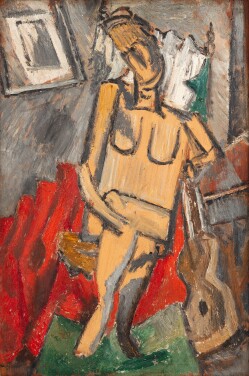H eaded to auction at Sotheby’s Paris on April 10, 2025, is the extraordinary collection of a leading figure of the Brazilian avant-garde: Niomar Moniz Sodré Bittencourt. Here, the collector’s grandson Mauro Moniz Sodré speaks with Sotheby’s about the impact her advocacy had in Brazil.
Picasso, Giacometti and More: the Collection of Brazil's Niomar Moniz Sodré Bittencourt
In one word, what was your grandmother, Niomar Moniz Sodré Bittencourt, like?
Courageous. Niomar was a woman of extraordinary bravery, tirelessly defending individual freedoms, freedom of expression and freedom of the press. Some have described her temperament as stormy and untamable, but I assure you she was also incredibly fun and full of charm.
Your grandmother founded the Museum of Modern Art of Rio de Janeiro in the 1950s. How would you describe the cultural environment of that era? What models inspired her approach?
In the 1950s, Rio de Janeiro was a city teeming with cultural fervor. Brazil was seeking to strengthen its ties with the United States amid the Cold War, and modern art was flourishing. Niomar and her husband, Paulo Bittencourt, were already avid collectors – deeply passionate about art and part of an intellectual and cosmopolitan elite closely connected to Nelson Rockefeller, whose family had established MoMA in New York. It was, in fact, upon the advice and support of the Rockefellers that she decided to create a modern art museum in Rio in 1952.
The MAM initially settled in the Capanema Palace, an iconic building designed by young Brazilian architects, including Lucio Costa and Oscar Niemeyer, under the guidance of Le Corbusier. Public enthusiasm was immediate: exhibitions, publications and children’s art workshops flourished, all supported by a dedicated column in Correio da Manhã, the newspaper owned by Niomar and Paulo Bittencourt.
In 1958, the MAM moved permanently to an iconic building within the gardens designed by Roberto Burle Marx. This ambitious project, driven by a collective enthusiasm, transformed MAM into a flagship institution, just as Niomar had envisioned.
The museum quickly became a key cultural institution, assembling a remarkable collection that included a Jackson Pollock artwork gifted by the Rockefeller family. With the help of friends such as Marcel Duchamp and Maria Martins, Niomar managed to acquire works from both emerging and established artists, building a collection of great significance.
“She embodies resilience and courage in the face of adversity, her fight serving as a reminder that culture and the press are powerful weapons against oppression.”
How did Niomar Moniz Sodré Bittencourt build her personal collection?
Coming from a family deeply committed to culture and national journalism, Niomar was introduced to art and culture from an early age. Her husband, Paulo, was a cosmopolitan man educated at Cambridge, and together they explored art scenes across the world.
During their travels to New York, they forged privileged relationships with major galleries such as those of Sidney Janis and Pierre Matisse. Niomar also traveled to Peru and Mexico, where she met Diego Rivera, Frida Kahlo and Clemente Orozco. Together, they collected modern and contemporary artworks, blending international and Brazilian art. Their apartment, transformed into a private art gallery, gathered masterpieces of exceptional quality. Unfortunately, in 1985, much of this collection was destroyed in a fire – an irreparable loss for Brazilian art.
Niomar Moniz Sodré Bittencourt played a key role during Brazil's politically turbulent 1960s. What motivated her political commitment?
Niomar took over the management of the newspaper Correio da Manhã in 1963, following her husband Paulo’s death. True to the newspaper’s legacy, she quickly and resolutely opposed the military regime established in 1964. Correio da Manhã became a stronghold of dissent, denouncing violations of freedom and advocating for the amnesty of political opponents.
This courageous stance led to her arrest and imprisonment, while the newspaper itself endured violent attacks. She was eventually acquitted after a trial closely monitored by UN observers. Her unwavering elegance in the face of repression made her a central figure in Brazil’s intellectual resistance.
What is Niomar Moniz Sodré Bittencourt’s legacy today?
Niomar’s legacy is that of an extraordinary woman, both a champion of the arts and a defender of freedom. She embodies resilience and courage in the face of adversity, her fight serving as a reminder that culture and the press are powerful weapons against oppression.
Her role in the history of MAM and Correio da Manhã remains an inspiration for future generations. This March, the publication of a book about her life, followed by the auction of her collection at Sotheby’s, will further highlight her extraordinary life. Her commitment continues to inspire, especially for women who, like her, dare to defy conventions and pursue their ideals with passion and determination.



















